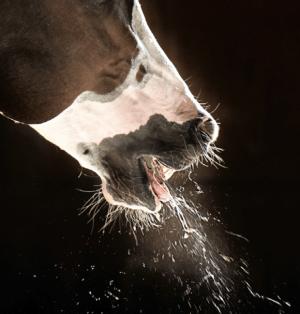Without vaccination, infection is possible across distances and in everyday care
By Kevin Hankins, Senior Veterinarian, Equine Technical Services, Zoetis
How close would you let a horse come to equine influenza? Of course, no one wants their horse anywhere near such a dangerous risk, but even half a football field away may still not be far enough to safely protect him from exposure to equine influenza.
Equine influenza virus (EIV), commonly known as the flu, is highly contagious and capable of traveling 150 feet through the air.1 It is transmitted rapidly from horse to horse over long distances and can survive on hands, clothing, brushes, buckets, stall walls, feed troughs, trailers and more.1 Flu infects the respiratory tract, including the cilia, which keep debris out of horses’ lungs. When the cilia fail to keep bacteria from the airway, your horse is at risk of a secondary bacterial infection, making EIV even more devastating.1
Any horse that travels is at risk of exposure to developing a fever, coughing and nasal discharge from equine influenza. An EIV infection can cause lengthy time off for the horse and, again, it is the leading infectious cause of death in horses.
Understanding how simply EIV is transmitted helps you understand the risks you’re taking if your horse isn’t vaccinated.
Contagious at 50 yards
Equine influenza spreads by coughing and can travel half a football field — that’s 50 yards. Playing with a virus that’s contagious over such extreme distance is a game no horse owner wants a part of. Vaccination that provides protection from exposure can be extremely beneficial.
When care becomes contagious
In addition to the rapid horse-to-horse spread up to 50 yards in the air, EIV can survive on your hands and clothing, along stall walls and simple equipment like brushes, buckets, trailers and feed troughs. Without vaccination against EIV, worrying about the virus traveling on all these surfaces becomes part of caring for your horse
Horses can spend weeks and months on the sidelines
Any horse suffering from equine influenza can require a lengthy amount of time to recover — anywhere from a minimum of three weeks up to six months without being ridden or heavily exercised. That’s a long time on the sidelines recovering from equine influenza for horses, and it keeps you out of the saddle and unable to take part in something you love.
Vaccinate to provide broad protection against EIV risks
Adult horses, in general, should be vaccinated annually against EIV, and those with increased exposure risks should be vaccinated every six months. Vaccination with FLUVAC INNOVATOR® provides protection against EIV and the many highly contagious ways it can spread to infect a horse. Since 2002, FLUVAC INNOVATOR has been tested against 29 emerging equine influenza virus isolates from top equine states, ensuring the vaccine remains immunologically relevant.2-8 Further, the Gluck Equine Research Center performed research using 37 EIV viruses from 24 different states to demonstrate cross-protective immunological relevance against recently isolated EIV strains.8,9
Tested and proven against current flu strain pressures in the U.S., FLUVAC INNOVATOR also is backed by the Zoetis Equine Immunization Support Guarantee. This guarantee provides up to $5,000 for reasonable diagnostic and treatment costs if your horse is properly vaccinated by a veterinarian and contracts the corresponding equine disease.
Talk to your veterinarian about vaccinating against this common but costly disease, and learn more about equine influenza at FluvacInnovator.com.
Read the AAEP Guidelines about Equine Influenza at: https://aaep.org/guidelines/vaccination-guidelines/risk-based-vaccination-guidelines/equine-influenza
1 American Association of Equine Practitioners. Equine Influenza Guidelines.
By Kevin Hankins, Senior Veterinarian, Equine Technical Services, Zoetis
How close would you let a horse come to equine influenza? Of course, no one wants their horse anywhere near such a dangerous risk, but even half a football field away may still not be far enough to safely protect him from exposure to equine influenza.
Equine influenza virus (EIV), commonly known as the flu, is highly contagious and capable of traveling 150 feet through the air.1 It is transmitted rapidly from horse to horse over long distances and can survive on hands, clothing, brushes, buckets, stall walls, feed troughs, trailers and more.1 Flu infects the respiratory tract, including the cilia, which keep debris out of horses’ lungs. When the cilia fail to keep bacteria from the airway, your horse is at risk of a secondary bacterial infection, making EIV even more devastating.1
Any horse that travels is at risk of exposure to developing a fever, coughing and nasal discharge from equine influenza. An EIV infection can cause lengthy time off for the horse and, again, it is the leading infectious cause of death in horses.
Understanding how simply EIV is transmitted helps you understand the risks you’re taking if your horse isn’t vaccinated.
Contagious at 50 yards
Equine influenza spreads by coughing and can travel half a football field — that’s 50 yards. Playing with a virus that’s contagious over such extreme distance is a game no horse owner wants a part of. Vaccination that provides protection from exposure can be extremely beneficial.
When care becomes contagious
In addition to the rapid horse-to-horse spread up to 50 yards in the air, EIV can survive on your hands and clothing, along stall walls and simple equipment like brushes, buckets, trailers and feed troughs. Without vaccination against EIV, worrying about the virus traveling on all these surfaces becomes part of caring for your horse
Horses can spend weeks and months on the sidelines
Any horse suffering from equine influenza can require a lengthy amount of time to recover — anywhere from a minimum of three weeks up to six months without being ridden or heavily exercised. That’s a long time on the sidelines recovering from equine influenza for horses, and it keeps you out of the saddle and unable to take part in something you love.
Vaccinate to provide broad protection against EIV risks
Adult horses, in general, should be vaccinated annually against EIV, and those with increased exposure risks should be vaccinated every six months. Vaccination with FLUVAC INNOVATOR® provides protection against EIV and the many highly contagious ways it can spread to infect a horse. Since 2002, FLUVAC INNOVATOR has been tested against 29 emerging equine influenza virus isolates from top equine states, ensuring the vaccine remains immunologically relevant.2-8 Further, the Gluck Equine Research Center performed research using 37 EIV viruses from 24 different states to demonstrate cross-protective immunological relevance against recently isolated EIV strains.8,9
Tested and proven against current flu strain pressures in the U.S., FLUVAC INNOVATOR also is backed by the Zoetis Equine Immunization Support Guarantee. This guarantee provides up to $5,000 for reasonable diagnostic and treatment costs if your horse is properly vaccinated by a veterinarian and contracts the corresponding equine disease.
Talk to your veterinarian about vaccinating against this common but costly disease, and learn more about equine influenza at FluvacInnovator.com.
Read the AAEP Guidelines about Equine Influenza at: https://aaep.org/guidelines/vaccination-guidelines/risk-based-vaccination-guidelines/equine-influenza
1 American Association of Equine Practitioners. Equine Influenza Guidelines.









